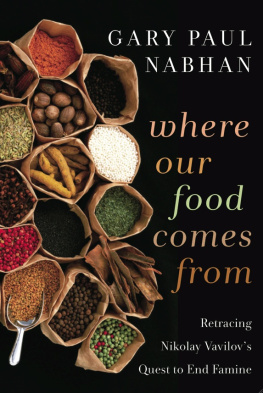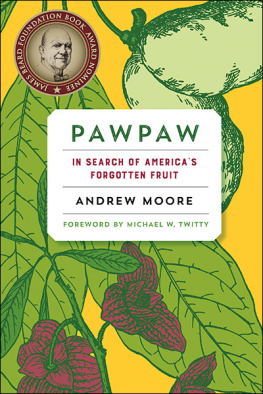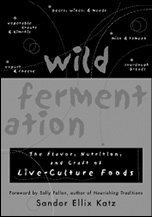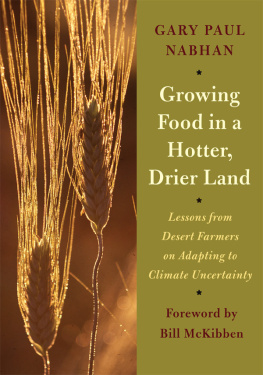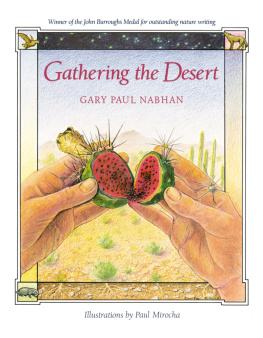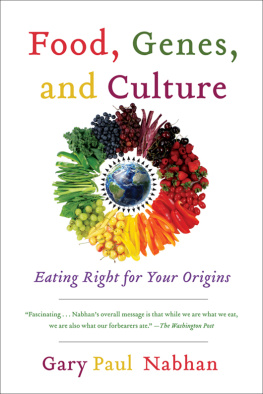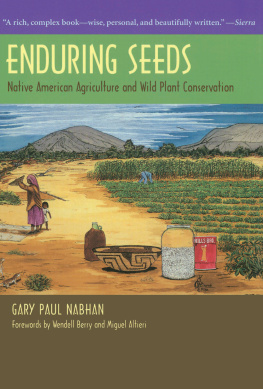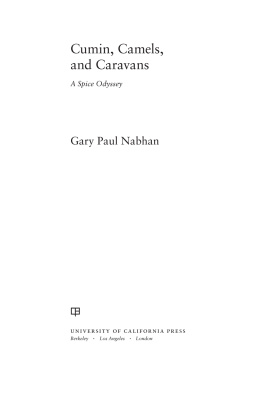Where Our Food Comes From
Retracing Nikolay Vavilov's Quest to End Famine
Gary Paul Nabhan
Foreword by Ken Wilson

Shearwater Books
Washington Covelo London
A Shearwater Book
Published by Island Press
Copyright 2009 Gary Paul Nabhan
All rights reserved under International and Pan-American Copyright Conventions. No part of this book may be reproduced in any form or by any means without permission in writing from the publisher: Island Press, 1718 Connecticut Ave., NW, Suite 300, Washington, DC 20009.
SHEARWATER BOOKS is a trademark of The Center for Resource Economics.
Library of Congress Cataloging-in-Publication data.
Nabhan, Gary Paul.
Where our food comes from : retracing Nikolay Vavilov's quest to end famine / by Gary
Paul Nabhan; foreword by Ken Wilson.
p. cm.
Includes bibliographical references and index.
ISBN-13: 978-1-59726-399-3 (cloth : alk. paper)
ISBN-10: 1-59726-399-0 (cloth : alk. paper)
1. Centers of plant diversity. 2. Vavilov, N. I. (Nikolai Ivanovich), 18871943. 3. Food
cropsGermplasm resourcesCollection and preservation. I. Title.
QK46.5.D58N33 2009
581.6'32dc22 2008013945
British Cataloguing-in-Publication data available.
Printed on recycled, acid-free paper 
Design by Brian Barth
Manufactured in the United States of America
10 9 8 7 6 5 4 3 2 1
Keywords: Famine, hunger, agriculture, farming, seed bank, biodiversity, cultural diversity, Russia, Stalin
For Laurie Smith Monti, who traveled with me retracing Vavilov's steps and who works daily to ensure that biodiversity, cultural diversity, and environmental health will be shared with future generations.
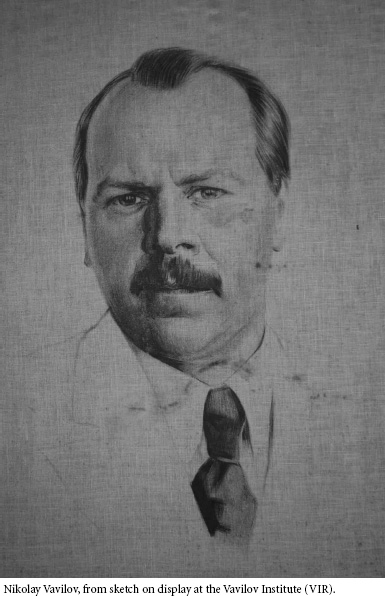
Foreword
Food is back on the mainstream agenda. Some eight hundred million people can't afford the food they need and an even greater numbernow some one billion peopleare obese and suffering from unbalanced diets. Industrializing food production by making production directly dependent on fossil fuels was amazingly successful in the short run, especially if you didn't take into account the rest of the ecosystem, and whether food was about more than nutrients and profit, and didn't consider food's relationship to cultural identity, communing with the senses and with family, and delighting in the diversity and abundance of creation. Over the long run, which seems to be arriving at approximately this moment, such use of cheap energy to consume unlimited water and pour chemicals into soils hasas many anticipatedled to the specter that peak oil is now linked to peak water is now linked to peak soil and so to peak food. And all long before peak consumerism and peak population.
When food becomes just a commodity and interchangeable with energy we get the bio-fuels confusion. You get your SUV, linked to your army andlinked to your wallet, achieving satisfaction before my children's stomachs, and those of our grandchildren. You get the subsidy that enables you to be paid to convert energy into food and back into energy at a net loss. And you get the predictable claims whenever a system reaches breaking point that what we need is just one more technological breakthrough to fix what's starting to failrather than rethinking a new system out of the old. If food is back on the mainstream agenda, this book is the inside and underside of why.
Where does our food come from? Much of humanity no longer knows how to put their hands into the soil, and instead specializes in curating, with microwaves, long-dead objects found in fridges.
Rural peoplelet alone farmersare treated as endangered species to be patronized at best. We no longer have a way to learn from the fact that indigenous tribe X managed to feed themselves sustainably in a desert for several thousand years with only a few crises. Where is our science, we ask, when we hear that the world has destroyed a quarter of the irrigable land, lost thousands of tasty varieties of crops and livestock, and allowed farming economies and rural landscapes to break down? Hearing from scientists that things are complicated and generally not good, we join social movements and we despair of the powerful (while they tell us through their PR firms that they're joining us).
As usual, we think our times are unique. But as this fabulous book lays out, many of these same struggles were already under way in the first half of the twentieth century, when the roots of our current situation were sown. Therefore, to understand what we face in the twenty-first century we could do well to understand the science and politics of Where Our Food Comes From. One of the principal actors in this tale is a scientist few Americans have ever heard of; and most of those who have, have apparently misunderstood.
In the great Russian scientist Nikolay Vavilov (18871943), plant geneticists worldwide find an enduring hero, a founder of modern crop breeding, a man who died defending science in the face of Lysenko and political expediency as Soviet science rotted under Stalin and millions of peasants were silenced and starved. In this path-breaking book Gary Nabhan gently butpersistently reminds us that in Vavilov we also find another scientific hero, and one almost unknown. Ironically this other Vavilov is a hero for environmental and social justice activists troubled by the unintended consequences of that same post-WWII crop breeding revolution that Vavilov's discoveries helped to usher in. These consequences included the spread of industrial farming and the green revolution that contributed to the destruction of diversity in crops and their wild relatives, the neglect of ten thousand years of indigenous farming traditions, and erosion of the benefits arising from successful coevolution between landscapes, cultures, and foodways. Thus increasing yields in fields went side by side with decreasing resilience and sustainability in agricultural landscapes, and with a loss of cultural heritage.
Vavilov's ability to create founding ideas on both sides of the current global food crisis debate certainly reflects the brilliance of this unrestrainable thinker. Yet it also reflects the fact that his prime piece of research equipment was a mule (in fact, a large number of them, able to follow any hill path or field line and arranged rather like a parallel processor, with the redundancy that allowed the occasional one to fall into a ravine without all his samples being lost). Until, and perhaps despite, the development of Google Earth, it has been hard to beat the mule as a tool for understanding human ecology. Dr. Nabhan's ability to lead us, at this same close-observing speed, in Vavilov's footsteps marks this book uniquely as a biography not only of Vavilov but also as a biography of the very agricultural systems that informed the birth of agricultural genetics.
Nabhan shows us too that Vavilov had another great methodological asset for understanding crop varieties and how they fared in the field: his willingness to learn local languages and embrace farmers as colleagues as he searched across five continents for the meaning of diversity. Thus armed with the mule and the capacity to learn from the custodians of the seeds, Vavilov became the first to recognize for science that there was a geographic coherence and pattern to those ancient agricultural civilizations of mountain tribal peoples who had domesticated the thousands of plant species upon which we still depend for our food. These became the Vavilovian Centers of

